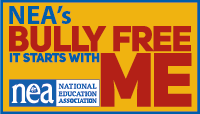 Bullying prevention programs do a good job of raising awareness and generating buy-in from school staff. However, programs can only do so much. For students to buy in, teachers, as first responders, must take the lead.
Bullying prevention programs do a good job of raising awareness and generating buy-in from school staff. However, programs can only do so much. For students to buy in, teachers, as first responders, must take the lead.
Beginning the school year with previews of the curriculum, overviews of rubrics and routines, expectations of homework, tardy policies, etc. is no longer adequate for creating a safe and supportive learning environment for kids. Ice breaker activities aren’t enough, either. Today’s teachers must be willing to engage in a direct dialogue with students about safety, concern, the freedom to make mistakes – and the opportunity to recover from those mistakes – respect, and acceptance. We must be willing to tell our own stories, share anecdotes, and assure students that we care about them, both corporately and as individuals.
The first day of school is a perfect time to share a bullying story of your own. As a K-2 student, I was picked on because of a speech impairment. When I spoke, the class whispered and giggled. Kids made sounds back to me at recess and lunch. Even relatives “teasingly” mimicked my inability to form the “S” sound correctly. As a result, I learned to use humor to divert attention from my speech to something else. I became the class clown as a way of coping. Thanks to a supportive and loving family, along with the outstanding work of a speech therapist, I was able to overcome the obstacle. Had I not, I very likely would never have become a teacher.
Why would a teacher use valuable class time to share a story like this? Aren’t there learning targets and state standards to work toward? Simply put, the story creates a connection. In a KidsHealth.com survey of 600 students, 55 percent reported being stressed out about social issues and appearance as they came back to school, while 32 percent said school work was a major source stress. Clearly, kids are thinking more about fitting in and feeling safe than about academic expectations. So it makes perfect sense that teachers would address kids’ chief concerns right from the start.
In her article for teaching.monster.com, Julia G. Thomson lists a few things that should be at the forefront of our thinking every day in the classroom: use a kind voice when you speak with students, always show a sense of humor, write notes to your students, and let students know you are there to help them accomplish their dreams. These are great ideas. Let's take a closer look at each one.
It is easy to slip into a tone of sarcasm or frustration without even realizing it. One way to use ensure you are using a kind voice is to tell students that you care. (Sound cheesy? It isn’t.) On the first day of school, teachers can clearly state, “Would it surprise you to know that I care about each one of you?” Go on to explain why teaching matters to you and why kids are worth every minute of time you invest in them. They need to hear this. They are craving special attention, and they deserve it.
Laugh when funny things happen in class—especially when they happen to you. Recently, with a student displaying a challenging attitude, I handed back an assignment and put my fist out, inviting a “fist bump” as he took his paper. He very lightly obliged, but I responded as if injured. I said, “I said fist bump, not fist break!” The class laughed; he laughed. I pretended to be my wife that evening, asking, “Honey, what happened to your hand?” My reply: “Anthony happened.” The class and Anthony laughed harder. “I asked for a fist bump, and he went Karate Kid on me.” More laughter all over the classroom. Anthony was all smiles and remained in high spirits the rest of the class period.
Write positive comments on their papers. Or, take it further. I used email addresses to contact families during summer vacation and request input about their children’s special interests. I then made personalized, laminated bookmarks reflecting students’ interests. The bookmarks were placed at students’ assigned seats on the first day of school, before we had officially met. I asked parents not to tell their kids about the bookmarks, which made for quite a buzz as kids entered the room for the first time. I heard comments like, “Okay how does he know that?”
In my classroom, I consistently remind students that: “It is my job to help you do well, so please ask for help.” I remind them that their questions matter to me and I am eager to help. The repetition of this promise eases tension and stress in students, making them more likely to raise their hand or approach me for assistance.
Such a list could continue for several pages. The consistent theme, however, remains an attitude of care and concern that goes beyond programs”and one-time events intended to raise awareness. Just because your school has a concern form students can fill out, doesn’t mean they feel valued and connected. Just as any viable curriculum includes clear learning targets, teaching requires specified targets aimed at shaping how children feel in the classroom. As leaders in our classrooms, it’s up to teachers to set those targets and ensure a safe and welcoming environment for all.
Chad Donohue is a middle school teacher, blogger, and adjunct professor living in Snohomish, Washington. Chad writes passionately about issues pertaining to educators, students, and families. He has been teaching since 1993.
 Find more resources and information at NEA’s Bully Free site: www.nea.org/bullyfree
Find more resources and information at NEA’s Bully Free site: www.nea.org/bullyfree


